
I’ve been swamped at work and home, so the range has been on hold for a few weeks. Today, however, it was time to go and collect some data on the new Weatherby. Lake Chabot isn’t exactly the type of place most people would avoid; a recreational lake, camping and a excellent large range facility. The sky was a little overcast, but eventually cleared, and highway traffic subsided after the first half hour on the road. It takes about an hour or so get there, much of that trying to clear Silicon Valley congestion.
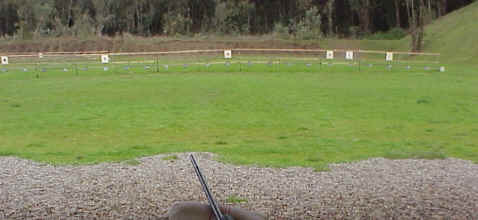 Here’s another good reason to go to the range on a week day. With threatening skies – that’s 6 targets hanging from over 50 shooting spots. Only the die-hards and people who need a lot of practice show up on days like this. No, I’m not a die hard.
Here’s another good reason to go to the range on a week day. With threatening skies – that’s 6 targets hanging from over 50 shooting spots. Only the die-hards and people who need a lot of practice show up on days like this. No, I’m not a die hard.
The grass looks nice and green, but there are actually enough deep puddles out there to water ski. Grumble, grumble….. my normal reaction to fresh air and getting outside for some exercise and a change of scenery.
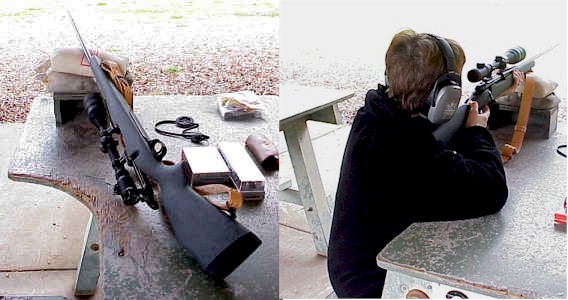
The lighting was a little extreme for the digital camera, they don’t adapt well to high contrast situations, but there’s the Weatherby and Burris scope. My wife, a person who swears she dislikes recoil, is sitting at the bench taking a few shots, and providing some interesting insight into how rifles get differing reputations for accuracy. More on this later. The fact my wife and I share a common interest in firearms has greatly enhanced our enjoyment of related activities. We go to the range together, go on boar hunts together, and she has been an excellent role model for out children in showing the safe and proper use of firearms. I know at times when I don’t feel like loading guns and equipment into the truck just to finish off a task to meet a deadline – good company, conversation and help pulling chronograph readings go a long ways toward turning the effort into an enjoyable day.
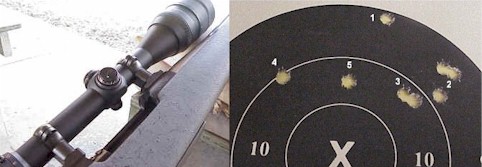
The Burris Scope and Leupold mounts were rock solid throughout the day. Nothing moved or worked loose and adjustment was positive. The scope had been setup with a Simmons’ bore sight before I left the house, which at least put me on the paper with the first shots. #1 was the first shot with the new gun. The trigger pull is too heavy for the moment, perhaps 5 lbs. Weatherby triggers are easy to adjust, but I didn’t want to interrupt shooting. Instead, I tried for a little more concentration. #2 is a slightly less than an one inch four shot group. I cranked the scope over 4 clicks (1/4″ – click) and shot #3, 2 shots in less than half an inch. Then I cranked the scope left 12 clicks and shot #4, then right 6 clicks and shot #5, which put me at a point blank on a 4 inch target of over 350 yards. As you can see, my method of fine tuning a scope is to chase bullet holes round the target until they pretty much settle a couple of inches above the bull’s-eye.
I don’t typically take cartridges under .308 and 100 grains of powder too seriously, but the little .257 was a lot of fun to shoot, I really like this gun. Each shot was punctuated with a few inches of muzzle jump, a little thump on the shoulder and about a foot of bright orange and red muzzle flash. Roy would be proud. Hopefully I’ll be able to figure out how to more completely burn the powder inside of the barrel, and how to keep the section of barrel just ahead of the chamber from getting hot enough to fry chicken.
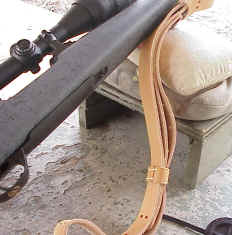 The competition shooting sling worked nicely for offhand and sitting shots. It had been a while since I used a sling for this purpose, but it was a comfortable and easy adjustment. The gun has an excellent feeling of balance, points quickly and is very steady on target. The barrel is a thin profile, but the gun never felt front end light.
The competition shooting sling worked nicely for offhand and sitting shots. It had been a while since I used a sling for this purpose, but it was a comfortable and easy adjustment. The gun has an excellent feeling of balance, points quickly and is very steady on target. The barrel is a thin profile, but the gun never felt front end light.
The Burris scope has an exceptionally clear, sharp image. I have Leupold scopes with adjustable objectives that don’t come close in clarity or contrast. The scope held zero throughout the magnification range without the use of the posi-lock. The thick portions of the cross hairs were a little overwhelming at higher magnifications, however, the central part was fine. The best feature of the scope is the small illuminated dot that is easy to hold on target.
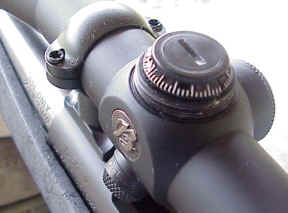 The only weak spots in the optical system are the Leupold parts, specifically the Torx fasteners. Prior to this Leupold setup, I used only Burris Signature rings and Burris mounts, but I would occasionally have a tube shift in heavy recoil rifles. The Leupold rings and mount system hold better, but they require a specialized Torx driver to tighten or remove them. To me this special tool requirement is a liability in the field, but not enough for me revert to Burris.
The only weak spots in the optical system are the Leupold parts, specifically the Torx fasteners. Prior to this Leupold setup, I used only Burris Signature rings and Burris mounts, but I would occasionally have a tube shift in heavy recoil rifles. The Leupold rings and mount system hold better, but they require a specialized Torx driver to tighten or remove them. To me this special tool requirement is a liability in the field, but not enough for me revert to Burris.
The scope adjustments were uniform and as advertised. I do need to shift the scope back about half an inch for a proper fit for eye relief.
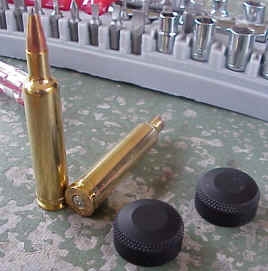 I was able to fire three types of factory ammo without taking out a second mortgage on the house: 87 grain, 115 grain Barnes-X and 120 grain Partition. Velocity was 3790 fps, 3416 fps and 3326 fps respectively, or very close to factory specs for the cartridge. I had enough 87 grain ammo for accuracy checking, but only enough of the other two for quick velocity readings. The short groups indicated above, where I discussed scope settings, were all shot with 120 grain partitions.
I was able to fire three types of factory ammo without taking out a second mortgage on the house: 87 grain, 115 grain Barnes-X and 120 grain Partition. Velocity was 3790 fps, 3416 fps and 3326 fps respectively, or very close to factory specs for the cartridge. I had enough 87 grain ammo for accuracy checking, but only enough of the other two for quick velocity readings. The short groups indicated above, where I discussed scope settings, were all shot with 120 grain partitions.
I believe it will be difficult to handload for tighter groups, but there is something to gain from broader bullet type selection, a significant cost savings and a potential upside in velocity. I may end up converting to neck sizing on this cartridge as factory ammo seem to expand significantly when fired. Maybe I’ll pick up a grain or two of capacity and work the brass less.
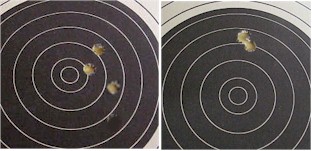 It was getting near the end of the session and I wanted to wrap up some group data for the little 87 grain round. I guess I had the thought in my head the lightest bullet weight would not group well. I was also beginning to get aggravated with the Ultra Lightweight’s ultra heavy trigger pull, having to use some sandbags instead of my own rest and shooting bags…. The best I could shoot was 1.25″. I was almost ready to leave on that note and write “the rifle shot heavy bullets with superior accuracy and repeatability, but it did not handle lighter bullets as well”. Fortunately, I tend to recognize when I’m losing concentration. I knew my wife liked the gun so I asked her if she wanted to take the last three shots before we packed up. Three minutes, three shots and a sub .500″ group with 87 grain bullets. Another time, in another place, headlines by a writer on an off shooting day might have been, “The .257 Weatherby is a high performance cartridge, but not capable of sub 1” groups.
It was getting near the end of the session and I wanted to wrap up some group data for the little 87 grain round. I guess I had the thought in my head the lightest bullet weight would not group well. I was also beginning to get aggravated with the Ultra Lightweight’s ultra heavy trigger pull, having to use some sandbags instead of my own rest and shooting bags…. The best I could shoot was 1.25″. I was almost ready to leave on that note and write “the rifle shot heavy bullets with superior accuracy and repeatability, but it did not handle lighter bullets as well”. Fortunately, I tend to recognize when I’m losing concentration. I knew my wife liked the gun so I asked her if she wanted to take the last three shots before we packed up. Three minutes, three shots and a sub .500″ group with 87 grain bullets. Another time, in another place, headlines by a writer on an off shooting day might have been, “The .257 Weatherby is a high performance cartridge, but not capable of sub 1” groups.
Summary
Around for 50 years, the .257 Weatherby has found yet another new fan. The little Ultra Light rifle, with it’s gray synthetic stock and Burris scope will see a lot of use. It’s a balanced package, able to deliver incredible accuracy from an almost pencil thin sporter weight barrel. I look forward to dragging it around in the field and working up handloads with the pile of bullets parked in my bottom left workbench drawer.
I plan on writing my next article on handloading the .257 Weatherby, but if I get bogged down in other responsibilities, I’ll see if I can change over to some quick projects in the interim.
More “The .257 Weatherby Ultra Lightweight”:
Pick up Day for the .257 Weatherby Ultra Lightweight
Scope selection for the .257 Weatherby project
.257 Weatherby handloading assessment
The Weatherby Mark V .257 WM at the range
Reloading the .257 WM …in excruciating detail Part I
Reloading the .257 WM …in excruciating detail Part II
Handload Data 257 Weatherby Magnum
Thanks,
Joe

Email Notification